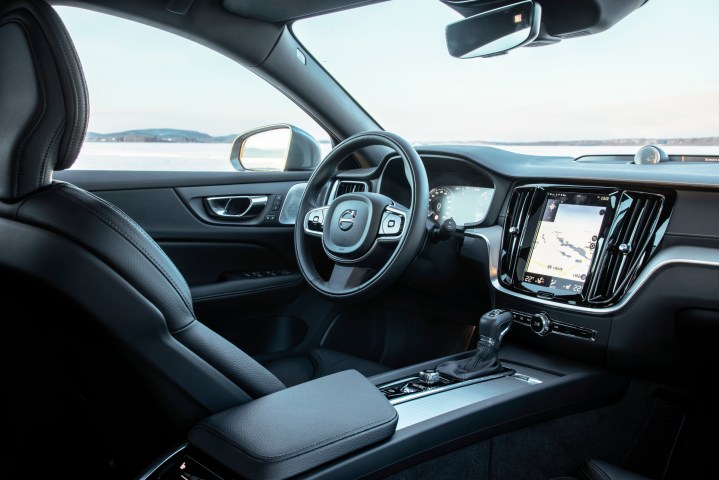
Volvo does many things well.
It’s a pioneer in the field of automotive safety. Its station wagons remain universally appreciated, even as the body style rivals the dial-up modem in unpopularity. And, its recent interior and exterior designs have all been home runs. It builds good, desirable cars, but it’s not a tech company, and it was humble enough to admit that when it asked Google and Intel for help in designing its next infotainment system.
That collaboration illustrates an on-going (and long-overdue) shift towards better infotainment systems, and Digital Trends expects similar tie-ups will become the norm during the 2020s. Ryan Tabrah, the general manager of Intel’s transportation solution division, shared his insights into why tech companies with decades of software experience stand in a much better position to design infotainment systems than automakers, and what that means for consumers in terms of convenience and privacy.
“We’re helping OEMs and Google bridge the gap,” he explained. Linking the two requires taking into account the unique requirements and design life cycles of vehicles and consumer electronics.
The shift is long overdue, because motorists are often underwhelmed and/or frustrated with the infotainment system programmed in their car’s dashboard. That’s why millions of drivers use third-party apps like Android Auto and Apple CarPlay, which completely override the native software. This puts the systems that automakers have spent millions on out of sight and out of mind. When it comes to technology, why are cars so far behind smartphones and laptops?
… It’s built from the ground up with multiple generations of Android in mind, so the software won’t get stale.”
“There’s usually a four-year gap between when a chip is designed, and when it gets put in front of a motorist. That’s why, historically, the experiences within vehicles have been very underwhelming compared to what you get on your phone. Consumer electronic products go through three to four life cycles in the time it takes an in-vehicle system to go from birth to consumption,” Tabrah explained.
Intel’s mission is to help ensure infotainment technology is still relevant by the time it reaches the market. The company’s partnership with Volvo (and Polestar, its digital sister company) has spawned a touchscreen-based infotainment system which addresses this problem in several ways.
“The system is unique because it’s built from the ground up with multiple generations of

Designing a future-proof infotainment system requires predicting the type and the amount of technology that automakers will need to pack into their cars in several years, and the features that consumers will ask for. For example, software developed today could have to support virtual reality-based in-car gaming – which Audi demonstrated ahead of CES 2019 – if it becomes the next big thing in the early 2020s.
For Tabrah and his team, the next chapter in infotainment technology will begin when a car knows its occupants like you know your friends. The car – whether it’s privately owned, shared, human-driven, or autonomous – what you might enjoy. It will remember what you liked on past trips, such as a burger restaurant you stopped at for lunch, and what you would rather not experience again, like that frighteningly narrow street peppered with roundabouts. It will detect your mood; it will know whether you’re happy, tired, or worried and adjust parameters like the music, the cabin temperature, and the ambient lighting accordingly.
Enjoying a smarter infotainment system will require going through an adjustment process.
Will we live in the future George Orwell predicted in 1984? Not quite, but there are obvious security concerns, and Intel is working with its partners to address them. Knowing what you like, where you drive, and how you feel inevitably requires tracking you. “This data will hopefully be used beneficially to help you feel like your car is almost reading your mind,” Tabrah assured us. “Most consumers that get into these vehicles that have more technology in them will have to better educate themselves on what they feel comfortable with in terms of privacy. I think that struggle will be real,” he concluded.
It sounds creepy but remember that we’ve been here before, and we are still there. Google knows where you ate yesterday, and it might ask you what you thought of the food. Facebook urges users to review their privacy settings on a regular basis. And, your Amazon Echo brings technological eavesdropping into the privacy of your living room.
Enjoying a smarter infotainment system will require going through a very similar adjustment process. Here again, Intel plans to use its decades-long experience to help narrow the gap between cars and tech as the two industries become irreversibly intertwined. By the 2020’s, the Volvos of the world will be able to bring phone-like tech straight into your dashboard and finally catch up to the computer in your pocket.
Editors' Recommendations
- Your car insurance company knows more about you than you think
- How crowdsourced lidar could give your car X-ray-like superpowers
- BMW and Harman want to bring 5G to your car. It’s harder than you’d think
- Uber’s self-driving cars head to Dallas, but they’ll be driven in manual mode
- BMW previews the next 4 Series with a concept car you’ll either love or hate




